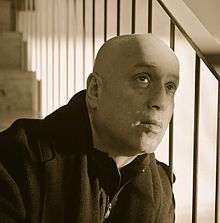Jiří Georg Dokoupil
Jiří "Georg" Dokoupil (born 3 June 1954) is a Czech-German painter and graphic artist. He was founding-member of the German artist group Mülheimer Freiheit and the Junge Wilde Art movement, which arose in the late 1970s and early 1980s.

Dokoupil lives and works between Berlin, Rio de Janeiro, Plovdiv, Dakar and Las Palmas..
Biography
Jiří Dokoupil was born in Krnov, then Czechoslovakia, in 1954. After the invasion of the Soviet army in Prague in 1968, he escaped with his family over Austria to Germany. In 1976 he began studying at the Academy of Fine Arts in Cologne. Later on he also attended classes at the Universities of Frankfurt and the Cooper Union in New York, where he studied among others under German concept artist Hans Haacke. The influence of Haacke is evident in Dokoupil‘s early work. From 1983–84 Dokoupil was guest professor at the Academy of Fine Arts of Düsseldorf and 1989 in Madrid.
In 1979 Dokoupil founded the group Mülheimer Freiheit with artists such as Gerhard Naschberger, Hans Peter Adamski, Gerard Kever, Peter Bömmels and Walter Dahn. The group was associated with the art dealer Paul Maenz who organised Dokoupil‘s first solo exhibition in 1982. In their shared studio in Cologne on a street named Mülheimer Freiheit, the six Jungen Wilden sought to explore a contemporary expression for their art by using a neoexpressive, figurative style of intensely colourful painting with traditional subjects and by overriding the intellectual, reduced formal language of Minimal and Conceptual Art. "I’d come to realize that the conceptual artists had become liars," Dokoupil has said. "What they had promised us was salvation, art without form. But I’d go into a gallery and there would be nothing to see, and it would be for a lot of money – that just couldn’t be it."[1]
But already in an early stage Dokoupil developed a less wild, rather unusual method of working and soon found his own radical subjective way with individual considerations. With his "book painting" shown at Documenta 7, Kassel, in 1982, Dokoupil attracted the attention of the art world. It was a gigantic material painting called God, show me your balls, a kind of homage to a Julian Schnabel plate painting, (which were made of broken ceramic dishes collaged into an image). Schnabel was not invited to participate in the exhibition – in Dokoupil‘s eyes a serious effront. Since then – besides the early group exhibitions with the Mülheimer Freiheit – Dokoupil's work has been seen in numerous one-man shows in galleries, museums and at other cultural sites worldwide.
Works
In accordance with the thesis of Dadaist Marcel Duchamp, Dokoupil never wanted to be subordinated to a personal or a forced style. He never developed a uniform style that would allow the observer to recognize his work. Rather he paraphrases different preceding styles, plays with them and invents new techniques. Only a certain expressivity and his affinity for eroticism may define his world of images. His oeuvre today contains over 60 series and far more than 100 devised techniques or styles. A selection of his series is listed below.
|
|
|
Since 1989 Dokoupil has developed the technique of Soot Paintings, painting projected images with soot of a burning candle or in larger works with the flame of a torch onto a blank canvas hanging flat from the ceiling. The Soot Paintings, often regarded as the most important series within Dokoupils oeuvre, contain different series such as the depictions of art auctions, the Subastas- series, of 1989 or recent ones called Leopards(2000–2009) or "Christ" paintings depicting Jesus Christ (a reference to his 1986/87 series of the Jesus paintings). For his Tire paintings of 1991–1992, he used freshly colour-dyed rolling tires on predominantly wet, ungrounded canvas. In his Soap Bubble Paintings of 1992-93 he lets soap-bubbles burst on canvas, while the liquid soap is mixed with colour or ink. In 2003 Dokoupil creates Whip Paintings by lashing a cowboy whip, which was stuck in a paint pot before, at the canvas. One of Dokoupil‘s most recent work is the series of spray-painted Buddhas on canvas. They are meant to be like Buddha, Marilyn and Mona Lisa all at once, since Warhol‘s Marilyn is the Mona Lisa of the 20th century.
Even though a retrospective of his oeuvre would resemble a group show of different painters, it has nothing to do with any pluralism of styles, with the claim of the coincidence of styles, or with a variety of post-modern irony. The focus of his multifaceted oeuvre is in fact on exploring original techniques and configurations generating a domain for playful experimentation and physical tension in which new images can arise and assuring that the act of making images is independent of the iconographic compulsions of the media world today. In that sense Dokoupil could be seen as an "artist inventor": inventor of styles and techniques ultimately a clearly conceptual approach.
Exhibitions
Selected Exhibitions:
|
|
|
Collections
Selected Collections:
|
|
|
Films
He acted in and co produced a few early films of Daryush Shokof amongst which dogs are not allowed, and Ben Hur ,the Breathless,Taxi Driver in Casablanca and Flushers in 2013 in Berlin, Germany.
See also
Bibliography
- Wilfried Dickhoff; Robert Fleck, eds. (2005). Dokoupil - Painting in the 21st Century. Hamburg: DUMONT. ISBN 3-8321-7553-9.
- Carlos Ortega, ed. (2000). dokoupil. Madrid: Museo Nacional Centro de Arte Reina Sofía. ISBN 84-8003-976-0.
- Pérez Esteban; José Antonio, eds. (2013). Cuadros de humo: una constante esencial en la obra de Jiri Georg Dokoupil. Múnich: Grin. ISBN 978-3-656-49637-3.
References
- "Dokoupil". 032c. Retrieved 13 December 2013.